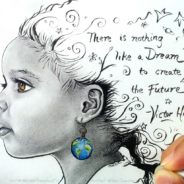Stronger than Dirt: A Recommended Book [Part One]
This is a book about a flower farm. It’s written in two voices, that of Kim Schaye and Chris Losee, a married couple in Brooklyn who moved out of the city to upstate New York to realize a dream—a vision. I’m quite sure that one reason I’ve enjoyed this book so much is because I get a kind of vicarious pleasure out of reading about someone—anyone—cultivating acres of flowers. But I also like the way this book begins at the beginning—when the flower farm was no more than a notion—and it proceeds to articulate the process of going from nothing—from scratch—into the realization of a vision. Interestingly, the story of the farm begins in failure. Chris, the husband, had been running his father’s construction business in New York for several years, business was booming, when in 1994, and rather abruptly, the construction boom busted and he found himself running the business out of his home and without the benefit of an income. In July of that year a concerned friend took him out to the tip of Staten Island to visit a place called Gericke Farm, a tiny farm which had once been a working farm and was now preserved as a demonstration farm inside a state park. They walked among the rows of crops. They picked tomatoes and zucchini and large bunches of flowers, and his friend told him he could show him how to make ten thousand dollars a year working part-time and on half an acre. The seed was planted. Between July and October of that year, and with a stack of books about small farming growing on his nightstand, Chris became convinced that he had stumbled upon their next venture. Of note, writing played a key role in moving what began as an idea—a dream—a vision—to a thriving farm. Chris writes: I’m not actually sure what made up my mind, but it might have had something to do with all the paperwork I was creating. I still have a time line, printed in choppy type on my old Apple dot-matrix printer from this period. It shows the months July 1994 through December 1996, and for each quarter of the year there’s a two- or three-sentence plan of action and a one-sentence goal. My wife says that I’m an obsessive list maker. But for me there is a quality of lists that is something like magic. Items on lists can acquire a certain inevitability. These are things that are supposed to happen, that will happen if given time and effort. And perhaps the gradual accumulation of books and lists had reached some critical mass that made the decision inevitable: write something down enough times and it becomes a fact. With writing as a catalyst, the facts begin to accrue for this couple. They find and then purchase thirty acres in the Hudson Valley with a stream running through it. Chris begins building them a house. He pores over seed catalogs. He orders seeds. He rigs up a system of plywood benches and grow lights—and a watering system no less—in the attic of their row house, and, after a decision to grow some vegetables along with the flowers, proceeds to start over three thousand tomato and pepper plants. They put up a fence at the farm, hire...
read more
